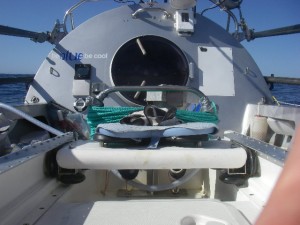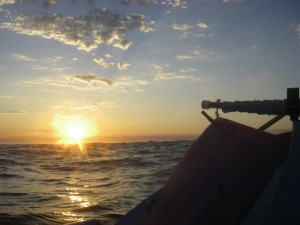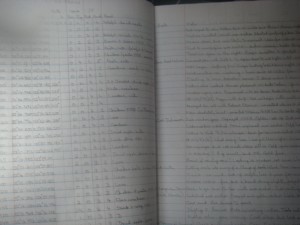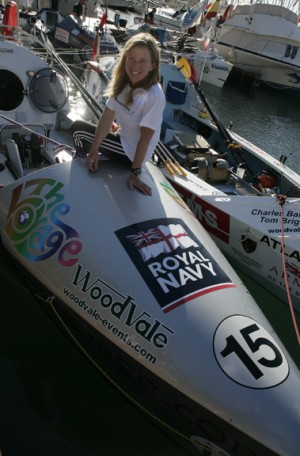20 Jun 2008, The Brocade

Continuing my series of descriptions of aspects of my day..
Rowing - that's what I do. And today I've done a lot of it and I'm knackered, so I'll keep this one short.
Some people are incredulous when I tell them what I do. This exchange is not untypical.
"What, no engine?"
"Nope, no engine."
"What, no sail?"
"Nope, no sail."
"Just rowing, huh?"
"Yes, just rowing."
"What, are you crazy?"
But no, I'm not crazy. I don't know how to sail (despite numerous attempts to learn) and I don't know how to maintain an engine, but I do know how to row - so when I was looking for my Perfect Project, rowing across an ocean seemed to me perfectly logical.
I rowed for 3 years at Oxford University, representing the university twice against old rivals Cambridge. Then I rowed for another 5 years in London, but had retired 10 years before I decided to do the Atlantic.
Now I seem to be back into rowing - with a vengeance.
Ocean rowing is a very different proposition from river rowing, but certain fundamentals are the same. I have a sliding rowing seat that glides on runners, similar in principle to what you would find in a racing shell, but seriously beefed up - see photo. Mine was built by Gig Harbor Boat Works in Seattle. I have oars, made of solid ash and wrapped in carbon fibre, made by Sawyers Paddles and Oars of Oregon. I have 4 oars in total - 2 main and 2 spare, with the spares doubling up as guardrails. My feet are held in the boat by New Wave rowing shoes fixed to a footboard.
So far, so similar, but there are a few differences. As I spend so much time on my rowing seat I need a bit of extra cushioning, so I have a pad made by Bottomliners. It has pop fasteners that clip on and off the rowing seat so I can take it into my cabin to keep it dry. On top of that I have a homemade cover made of the same fabric that camping towels are made from - fast drying and wicking.
Instead of having ordinary rowing oarlocks, I use chunky metal oarlocks more commonly used for whitewater rafting - much stronger for when conditions get rough. These are mounted into custom-made riggers that extend about 6 inches from the sides of the boat.
And finally I have my rowing gloves - kangaroo skin golf gloves made by Kakadu of Australia. I got through 5 pairs of these on the Atlantic, and I mean REALLY got through - I wore each pair until they were more hole than glove. They stop me getting open blisters - I get calluses, but no open wounds that would be vulnerable to infection.
Depending on weather, circumstances, and energy levels, I row for between 8 and 15 hours a day, in shifts of 2 or 3 hours, with half-hour or one-hour breaks. Nothing fancy about it - I just sit on my rowing seat, and I row, row, row...
[photo: my rowing seat, looking toward the stern of the boat (the way I face when I am rowing). Beyond my rowing seat you can see the cleat that I improvised yesterday so I could retrieve the sea anchor tripline.]
Other stuff:
A good day today. Weather conditions favourable, so a busy day's rowing, sunrise to sunset. Watermaker still working. New sea anchor rig functioning well. Life is good.
Thank yous and hellos to Rich and Marilynn Ames and Ken in Eureka, Stephanie Batzer, Cheryl Mannix, Mark York, David Jones
Special hellos to some faithful correspondents from the Atlantic crossing: Helena S-S: baffled by the riddle. Looking forward to the clue! And I shall aim to get my subjunctives correct in the future. (Oh dear, that doesn't seem quite grammatically correct either.!) Bonjour Jean-Francois! Sounds like you are working way too hard! And John F Taylor - yes, I really am most definitely out here!!!
Rob - thanks for spreading the word.
Chuck - I will try out the GPS remedy. Thank you.
Pippa - after seeing my logbook you think I would make a good accountant?! I am mortally offended!
Thanks also for comments from Ultrathoner, Bruce, Roberto, Dana, Ross and Bob.
Randy - thanks for all the questions. I will try to get round to answering them all in future blogs.
|
|
19 Jun 2008, The Brocade

Last night I went to bed feeling despondent, bordering on morose. My sea anchor was all snarled up in its tripline, and I couldn't figure out how I was going to get it back on board. Even worse, I seemed to be unable to break free of the California coast - I was being swept ever eastwards, and further away from Hawaii. I'd been trying to put a brave face on things, but I had been getting increasingly anxious over the preceding few days and wondering just how I was going to break free of this apparent deadlock.
This morning, as I was waking up, an idea came to me. The problem with the sea anchor was that although I could pull it in a certain distance, the next time a big wave came along it would yank the line out of my hands and I would lose the progress I had made. What I needed was a cleat that would allow me to wind the line around it, taking the strain off my hands and bringing the line in little by little. But I had no suitable cleats in the cockpit.
Aha! Lightbulb moment!
There is a grabrail in the cockpit that would serve as a cleat, if only I could put some kind of stoppers on it to stop the line sliding off the top when the tension bit. A couple of Quickfists (made by Davis Instruments) should do the trick, if I held them in place with duct tape.. I jumped out of my bunk (well, as much as you can jump in 3 feet of headroom) and set about implementing my brainwave.
It was one of those deeply satisfying experiences, when you have a good idea and you put it into practice and it goes exactly as you hoped it would. I built my cleat, hauled in the sea anchor, spent a couple of hours sorting out its tangled lines and refined its design to try and avoid similar problems in the future.
I then spent the rest of the day rowing, putting in a solid 8 hours and clawing back a few miles westwards. Suddenly the world seemed a better place.
But I try to remind myself - as I did during the tough times - nothing lasts forever. So I mustn't get over-excited. Many trials lie ahead, and not every day is going to be as good as today. It's all yin and yang, ups and downs, swings and roundabouts.
But it was really, really good to have such a successful day - a great boost to morale.
[photo: thought about showing off my improvised cleat, but tonight's sunset was too pretty not to share]
Other stuff:
And MORE good news! Audible.com are going to sponsor my thrice-weekly podcasts with Leo Laporte. This will earn me a little bit of revenue, depending on how many people download our podcasts. So if you are not already following our chats, PLEASE DO! As well as being informative and (hopefully) entertaining, they are now also cash-generators for my efforts to spread the message. On Tuesdays and Thursdays Leo and I talk together, and starting from this weekend we will be doing a Q&A session on Saturdays, where listeners get to call in and ask me their questions. Check it out!
Thanks to Jennifer Raiser for her lovely message. Nice to know that the Woodside gang still care, and if I am back on dry land when Burning Man comes around I will certainly bear it in mind. Burning Man is most definitely on my list of things to do - although as you say extreme camping may not be top of my list of priorities just then!
Hey Russ on the Farallones - great to hear from you! Glad you finally got your antenna (and email) back. The bananas and M&Ms and trail mix were VERY much appreciated - alas now a long-distant memory.. Do you realize, you guys were the last human beings I saw - and that was over 3 weeks ago now?!
Thanks to Simon Chester for the blog. Tom Sweeting - thanks for the offer of a delivery. A slice of pecan pie would be nice. only kidding! Andy White - took me about a week after I arrived in Antigua to be able to walk properly. Very strange experience! Ken Weaver - thanks for the message, and the job offer - but in the nicest possible way, I hope never to need to take you up on it!
Hi also to Robert Forrester, Rob Mohle, John H (very interesting about the ear canals going to sleep!)
Tim Woodman - hope the mantra works for you. It does the trick for me - usually! The subconscious is apparently extra-receptive at that time, just as you are waking up.
Conservation Corner: special hello to Margo - a kindred spirit. And to Dana and the paper recycling mission - keep up the good work! And Bruce Tomlinson (joined car pool, stopped using paper cups) - really encouraging to hear stories of people making changes for the good of the planet.
Current position is .
32 35.259 N, 123 28.554 W
|
|
18 Jun 2008, The Brocade

This is Part 2 of my descriptions of little moments from a typical day - my logbook.
I sit cross-legged in the eighteen-inch wide sitting area, my back against a grey Pelican case strapped to the wall of my cabin. This case contains my MacBook, mobile phones, various cables, and an external hard drive. I turn to my right, and pull out a folder-sized black Aquapac from a blue elastic strap that retains both the Aquapac and a large black Pelican case containing my Toughbook PC. For now I don't need the electronics - just the Aquapac that protects my logbook from the seawater and condensation that get everywhere.
I unclip the waterproof seal at the top of the Aquapac and take out my logbook - an A4 sized notebook in a reassuring, old-fashioned style. I reach across to the opposite wall of the cabin and take a pencil from the wall pockets, and extricate my TomTom GPS device from the pile of snacks.
I hadn't planned to use the TomTom - I have a proper marine chartplotter that gives me latitude and longitude and a whole load of other information besides - but unfortunately, soon after I set out, the chartplotter stopped being able to fix a position from the satellites and all the other functions depend on that. I suspect that the antenna on the cabin roof did not appreciate its dunking during the capsizes last year, and just chose a bad time to stop working. So now I use the TomTom out of my car. It's not designed for marine use, but it will do for now. If/when it dies, I have another GPS too.
I have ruled the pages of my logbook into columns to track various aspects of my ocean existence. Date, time, latitude, longitude, wind strength (estimated) and direction, hours rowed, hours slept, and marks out of 5 for state of body and mind. Also some wider columns for what food I have eaten, what book I am listening to, and general notes.
I turn on the TomTom. It also lives in an Aquapac, and I can operate it without taking it out of the waterproof bag. While it busies itself homing in on the satellites, I look out of the hatch at the ocean outside as if looking for landmarks that will give me some clue as to where I am relative to yesterday. But of course, this piece of ocean looks exactly like the piece of ocean where I was last night. Maybe rougher, maybe calmer, but still wet and watery and indistinguishable from any other bit of ocean.
After a couple of minutes the TomTom displays my new position. I may have drifted in a favourable direction (south and/or west) during the night, or I may not. I try not to over-react either way - with varying degrees of success. Good times change for the worse, and bad times change for the better, so I'll permit myself a small celebration or a small grumble and that's all. It is what it is.
I copy the coordinates into my logbook. I fill out the other columns, the quality of my handwriting depending on the sea state, and carefully return the logbook, pencil and TomTom to their respective homes.
I repeat this ritual between 4 and 6 times during the day, depending on whether it is a rowing day or not. I find it comforting to slowly fill up the pages of my book with columns upon columns of tiny numbers and words. I may not be in control of my destiny, but at least the logbook gives me some illusion that I - and not the ocean - am running this show.
Other stuff:
Steve - thanks for taking a look at my Amazon wish list (see the Amazon link button top right), and thanks also for the suggestion about paperbackswap.com. I hadn't come across that one. Sounds a bit like bookcrossing (I think).
If you're into books, you may be interested to know that I have written reviews of the books that I have been listening to during this crossing. I have sent them to my mother today and she will be posting them to Goodreads.com. My user name is rozsavage.
Rachel, your record stands unbroken. I washed my hair today, not even 4 weeks into my voyage, and a long way short of your 6 weeks record. It wasn't an easy exercise - kneeling on the rolling deck of the boat, head-down in a bucket - but it was worth the effort. I feel SOOO much cleaner!
And of course I use my lovely organic Green People shampoo and conditioner, so I'm not tipping anything inorganic into the ocean along with the washing water.
The watermaker worked today - hence celebratory bathing extravaganza.
Hellos to Laila and family, Rich Hular, Francesca Bellini (Pacific rower Alex's wife), James Ruth, Clint, and Rob.
And hellos to those following the podcasts: Richard - NC backpacker, Michael Church - and a special hello to John Stevens, and kudos to you for finding strength in adversity. As I'm sure you know, life is always changing, so bad times never last forever. Wishing you all the best for a brighter future.
Thanks to Russell Manchester for the information that Sunfish mainly eat jellyfish. I suddenly see Sunfish in a whole new light - my friends!
Thanks in advance to Thomas Sweeting for the neoprene socks. I look forward to having those for future stages of the row.
Eric - I am coming to the same conclusion myself, that my two aft batteries are not in good shape. Shouldn't be too much of a problem, provided I use the power-hungry appliances such as the watermaker and the inverter during daylight hours only.
And finally, a special hello to Martine Sevik, and thanks for her wise words: "The trick is to learn to sing while it's raining." Absolutely! And I'm learning..
|
|
17 Jun 2008, The Brocade

[Photo: Roz and the notorious cabin roof in calmer waters in La Gomera, Nov. 2005]
Today I scared myself half to death. But only half, and I'm sure that half will soon recover itself.
I had to go out over the roof of the forward cabin again. This is never an enjoyable experience - the roof is curved and smooth and offers nothing in the way of handholds or footholds - but I really had no choice. The main line to the sea anchor was chafing on the towing eye and I wasn't sure it would last until the wind and waves calm down, so I had to get out there and do something about it.
I put on my harness and clipped it onto the safety line that I've set up across the cabin roof. I swung myself around the metal frame and sprawled across the roof in an effort to stay out of the water. But within a minute the large waves had knocked me off and I was dangling half in, half out of the water.
Now I'm here I might as well do the repair, I thought, and worked as quickly as I could, one handed, trying to lash a protective piece of rubber around the rope with duct tape, while the rope slackened and tightened with every passing wave. It was not a very elegant job, but I hoped it might do the trick.
Now the hard part - I had to get back on board.
This was not at all easy. There are grablines around the side of the boat - loose loops of rope suspended from eyes fixed into the hull - but they were at about hip height, so not easy to get my feet onto them. Even once I got a foothold, the waves crashing over my head and the tiredness in my arms made it impossible to get back onto the roof. I was hanging sideways alongside the smooth hull of the boat, getting colder by the moment, and unable to find the strength to pull myself back on board. I tried to stay calm. No point in panicking.
I took hold of the karabiner that linked my harness to the safety line, and managed to work it along the line towards the cockpit. I came a little more upright, but still couldn't reach safety. I was really running out of options now, and was wondering just how this would end. I offered up a little prayer.
A large wave came along and I used its surge to lunge for the metalwork frame on the cabin roof. I didn't manage to grab it, but I had a pair of scissors that I had lashed to my wrist to help in the repair job and these scissors caught in the frame. The cord tightened around my wrist. It hurt, but at least now I was closer to getting a proper handhold. I grabbed the frame and with a final effort managed to swing my leg around into the cockpit.
I was safe. Exhausted, but still in one piece and back on board. I stood there for several moments, spitting out seawater and thanking my lucky stars that I was still alive.
I was soaked to the skin, and it has taken me several hours to warm up, but apart from a few minor cuts and bruises I am fine. While I'm clipped on to the boat there's no way that I can become detached and drown. But exhaustion and hypothermia are very real risks, and with nobody around to help me they are risks that I cannot afford to take.
So it will be a while, or much calmer weather, before I go out on that roof again. It's just too dangerous a place to be.
Other stuff:
A big thank you to all who continue to follow my blogs, podcasts, and text messages.
And an especially big THANK YOU to all who have donated, either as a one-off or as a recurring monthly donation. All donations of $20 or more will be acknowledged in the scrolling Thank Yous at the top of this blog. (This may not be visible on some browsers). In answer to one question on the podcast - no, I do not have a private income (or a public one, come to that!), so all donations really are very much appreciated, helping me to spread the environmental message.
The watermaker worked today. That makes twice in a row that it has worked on demand. At first it sounded a bit grudging, like an old man being woken up from a satisfying snooze, but went on to do what it was asked without any fuss. Looks like the "oomph" theory might be working.
At the time of writing, I haven't yet received the latest batch of blog comments and email messages via my mother - presumably because yesterday there was a bit of a flap at mission HQ due to a lack of updates from my locator beacon. I'll catch up on them tomorrow - along with the next part of the "Welcome to my World" series.
|
|